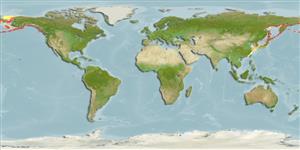Teleostei (teleosts) >
Perciformes/Cottoidei (Sculpins) >
Cottidae (Sculpins)
Etymology: Myoxocephalus: Greek, myos = muscle, and also, mouse + Greek, kephale = head (Ref. 45335).
Environment: milieu / climate zone / depth range / distribution range
Ecology
Marine; brackish; reef-associated; depth range 0 - 60 m (Ref. 50550). Temperate
North Pacific: Unalaska I., Aleutian Is. To SE Alaska at Port Conclusion; Commander Is. and east coast of Kamchatka to Sea of Okhotsk and to Sea of Japan to South Korea.
Size / Weight / Age
Maturity: Lm ? range ? - ? cm
Max length : 62.0 cm FL male/unsexed; (Ref. 115020); max. published weight: 4.0 kg (Ref. 115020); max. reported age: 12 years (Ref. 56449)
Occurs in the littoral zone (Ref. 26334), over rocky reefs (Ref. 559). Enters rivers (Refs. 2058, 37812).
Life cycle and mating behavior
Maturities | Reproduction | Spawnings | Egg(s) | Fecundities | Larvae
Nakabo, T., 2002. Fishes of Japan with pictorial keys to the species, English edition II. Tokai University Press, Japan, pp 867-1749. (Ref. 43239)
IUCN Red List Status (Ref. 130435)
Threat to humans
Harmless
Human uses
Fisheries: commercial
Tools
Special reports
Download XML
Internet sources
Estimates based on models
Preferred temperature (Ref.
123201): 0.6 - 8.5, mean 2.6 °C (based on 572 cells).
Phylogenetic diversity index (Ref.
82804): PD
50 = 0.5000 [Uniqueness, from 0.5 = low to 2.0 = high].
Bayesian length-weight: a=0.00813 (0.00446 - 0.01481), b=3.18 (3.01 - 3.35), in cm total length, based on LWR estimates for this species & (Sub)family-body (Ref.
93245).
Trophic level (Ref.
69278): 3.7 ±0.2 se; based on size and trophs of closest relatives
Resilience (Ref.
120179): Medium, minimum population doubling time 1.4 - 4.4 years (Preliminary K or Fecundity.).
Fishing Vulnerability (Ref.
59153): Moderate to high vulnerability (54 of 100).
Nutrients (Ref.
124155): Calcium = 41.2 [6.4, 105.8] mg/100g; Iron = 0.155 [0.048, 0.466] mg/100g; Protein = 19.7 [16.8, 22.0] %; Omega3 = 0.349 [0.144, 1.013] g/100g; Selenium = 9.39 [3.79, 23.61] μg/100g; VitaminA = 39.5 [10.9, 145.8] μg/100g; Zinc = 0.916 [0.357, 1.861] mg/100g (wet weight);
